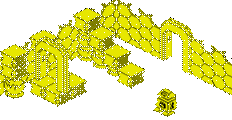






|
 Connectors Connectors
- a cartridge slot for cartridges from 2K up to 32K - 24-pin edge connector slot
- two controller ports, e.g. for joystick or paddle - 9-pin male D-type
- a power supply socket (from either the monitor or the TV modulator)
- 9V DC.
- expansion slot (only found on some early 7800s) - reportedly for a planned connection to a (never released) laserdisc player
 Technical Facts Technical Facts
- Early 7800 units shipped with an expansion slot on the left side of the casing, but no hardware was ever released that took advantage of it. Rumor has it the plan for this was for connectivity to a laserdisc player, which never materialised.
- The 7800 is backward-compatible with the 2600 primarily because it includes many of the same chips. When running in "2600 mode", the 7800 uses the TIA (Television Interface Adapter) for both graphics and sound, and reduces its speed to 1.19 MHz to mirror the performance of the 2600's stripped-down 6507 CPU. Further changes in 2600 mode include RAM access restricted to 128 bytes foud in the RIOT, and game data being accessed in 4K blocks. When running in normal 7800 mode, the TIA serves only to produce the sound, whereas the new MARIA chip (6502C) becomes responsible for the graphics. Game data is accessed in 48K blocks.
 Trivia Trivia
- On systems sold outside North America, Asteroids was included in the 7800's operating system ROM, and in Australia and New Zealand it came bundled with a 32-in-1 cartridge, although this was just relabelled 2600 version of the same.
- The 7800 was planned not just for games, but also to be expandable to a fully fledged home computer. As such, a keyboard was developed which also had an expansion port for further connection of a printer or disk drive. The manufacture of the keyboard fell victim to Jack Tramiel's takeover of Atari from Warner Bros in 1984, where the marketing budget for the 7800's launch was slashed to a mere $300,000.
- A high-score cartridge was also planned, which could save the high scores of up to 65 seperate games. Designed as a pass-through device similar to the later Game Genie, nine programs were released that made use of the high-score cart, but sadly it was cancelled before it was released to manufacturing.
|
| |
|
|
 Connectors
Connectors Technical Facts
Technical Facts Trivia
Trivia 







